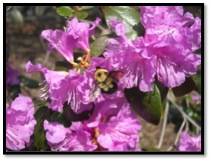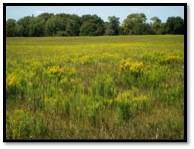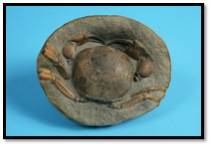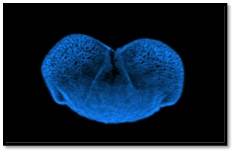Every trip to the museum is the same for me. Whether I look at the dinosaur bones, the mummy, or the artifacts from civilizations now lost to us, I am simply enthralled by all things dug up from the past. In school, however, history classes are not my favorite. Instead, I always gravitate towards science and mathematics, so it makes sense that I am starting my PhD in a biology program at the University of Illinois. Thus, it is not the inherent concept of “history” that draws me to everything in the museum, but instead the ability of people to unearth such things, analyze them, and somehow illustrate a story about the past using their present scientific tools. As the trips to various museums accumulated and my years in school flew by, I knew that I wanted to meld the practice of investigating the past to science.

Twelve million year old crab fossil, photographed by Wendy Kaveney
The history of the Earth is much longer than the one taught in our American or European history classes; in fact, there are 4.5 billion years of Earth history ready for scientists to study. Investigations into Earth history often involve looking at the fossil record, which is the world’s cache of golden keys to the past. From dinosaur skeletons to crab shells, the fossil record is a wide window that overlooks Earth history.
Though animal fossils are fascinating, my fossils of choice are those from plants. Whether I travel to a brand new location or just stroll through Busey Woods, I always stop to “smell the roses.” In other words, the plants are the organisms that catch my eye and make me stop to observe, wonder, and admire (and always photograph!). Don’t get me wrong; I also love animals, but when it comes to a lifelong career in science, I am set on studying plants.
Though plants do not have hard, calcified bones to leave behind, they do have very strong structures capable of surviving for millions of years nonetheless. Perhaps surprisingly, one of these particular fossils is pollen. Fossil pollen grains are both abundant and well preserved due to a very sturdy compound in their outer layer. Therefore, fossil pollen grains are to plants as bones are to dinosaurs.

It looks like a bumble bee made its way into the flower shot!
Pollen grains are necessary for plant reproduction, and they all possess definitive shapes and textures that represent the identity of the parent plant. However, in order to see these features, you must use a microscope because pollen grains are tiny! Some pollen grains are spherical, while others are triangular. Some pollen grains have rough textures, and others are very smooth. For example, if a pollen grain has a triangular shape with a very bumpy surface, then you might be able to link the pollen grain to its parent plant based just on the shape and texture. Take a spruce pollen grain for example: Its Mickey Mouse shape and the texture of its mouse-ear appendages both aid in identifying the exact species of the parent spruce tree. Therefore, shape and texture of pollen grains can usually tell us the identity of the plants from which they came.
Let’s tie features of pollen grains to their usefulness in the fossil record. Since we know that pollen shape and texture are indicators of the parent plant, looking at fossil pollen that is very well preserved will tell us about the parent plants that existed on Earth millions of years ago. Fossil pollen is the ticket to my life’s dream of using science to reconstruct Earth history. Considering there are 4.5 billion years of Earth history to investigate, however, I need to focus on a particular timeframe if I am to conduct quality research and unveil informative results. My timeframe of interest is between about 23 and 2.5 million years ago. Why would I focus on this tiny timeframe within the incredibly long history of Earth? Well, the globally important reason happens to also surround Urbana-Champaign as you read this article.
Grasses exist almost everywhere on Earth, and they are the main components of many important ecosystems. From Midwestern croplands to the African savanna, grasses cover up to forty percent of the Earth’s land surface according to Southern Illinois Professor David Gibson. Just think about the acres of corn surrounding the Champaign-Urbana area alone. Yes, corn is a type of grass — and a very important one at that! Grasses such as corn, rice, wheat, and barley are major components of the human diet. Aside from grasses in nearby croplands, there are also many grasses in the prairies of local park districts. In a report to the Urbana Park District, John White notes that the prairie vegetation of Meadowbrook Park consists largely of grasses such as Wild White Indigo and Indian Grass. These grasses, along with the beautiful wildflowers of the prairie, make your stay at the park more scenic and enjoyable.

An example of grassland in northeastern Illinois, photographed by Allan Scott Walker
The care and attention to places where grasses live, such as croplands and grasslands, are amplified on a worldwide level through scientific studies and conservation efforts. For example, the Nature Conservancy protects the Llanos Grasslands in Colombia and Venezuela from destructive human activities, such as agricultural expansion, in an effort to preserve the natural biodiversity and productivity of these rich tropical grasslands. Nearly 100 mammal species and 300 bird species make their home in the Llanos Grasslands alone! In addition to conservation efforts, many scientific studies are dedicated to understanding the evolution and ecology of grasslands, and multiple databases dedicated to providing information on grasses exist on the Internet. For example, Stephen Long at the University of Illinois is the principal researcher on a long-running project that researches the biofuel potential of the grass Miscanthus. Thus, from our very own Urbana Park District and University of Illinois to the Llanos Grasslands in South America, grasses are a global concern.
It is very clear why grasses are important plants. Many crops are grasses, the potential for biofuels stems from grasses, and major conservation agencies strive to protect grasses, among many other reasons for their importance. Therefore, considering that grasses compose major ecosystems and economies on Earth, it is imperative that we understand how grassland diversity will respond to current global environmental change. Diversity is the measure of how many species there are in an area, and it is also an indirect measurement of the health of an ecosystem. Will there be a major loss of grassland diversity and decreased ecosystem health due to the projected environmental change? What will be the consequences of this happening? In order to better determine the answers to these questions, we need to consult the past.
I discussed earlier that the shape and texture of pollen grains reflect the parent plant, and that pollen grains preserve so well in the fossil record that we can discern the parent plants from millions of years ago. I also mentioned earlier that my timeframe of choice in Earth history is 23–2.5 million years ago because of grasses. There is a reason for this! It is because grasslands became dominant ecosystems between 23–2.5 million years ago, and I want to know what kinds of grasses composed these first grasslands and how past grassland diversity changed in response to major geological and climatic events throughout the aforementioned timeframe. We absolutely need to use fossil pollen to determine the diversity, or number of species, of past grasslands in order to understand the health of the grasslands before, during, and after major environmental change. My passion to utilize fossil pollen in order to understand past grassland diversity response to global change will also elucidate the potential response of grasslands to current global change.
Written by Cassie Wesseln, Ph.D. student in the Department of Ecology, Evolution, and Conservation Biology at the University of Illinois.
Unless otherwise noted, all photos by Cassie Wesseln.
~~*~~
Smile Politely is proud to introduce a new running series we are calling “Science Politely” that will feature the work of graduate students at the University of Illinois throughout November and December. Working in collaboration with the students in a graduate course in Integrative Biology, Science Politely is a collaboration aimed at bridging the gap between town and university, between scientist and citizen, and between research and culture.









